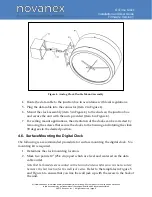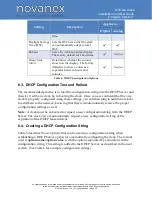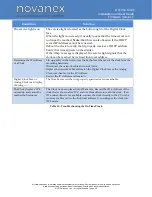
OnTime Clock
Installation and User Guide
Firmware Version 1
All claims based on information publicly available at time of printing. All other product or service names mentioned
in this document may be trademarks of the companies with which they are associated.
© 2015 Novanex, Inc. | All rights reserved | page 21
Option
Name
Option Value
Configuration
Setting
Description
timeserver
SNTP Time
Server name or
IP address
SNTP Primary Time
Server
(sntp
–
h command)
Sets the Primary SNTP Time server Host
Name or IP address to use for time
synchronization. If a Host Name is used, then
the DHCP Server must also provide a DNS
server to use to resolve the Host Name.
timezone
hh:mm time
offset
Timezone offset
(timezone command)
Sets the number of hours and minutes to offset
from UTC time when displaying time. This
can be negative. The minutes (:mm) are
optional.
dst
none, [rule
specification]
Daylight Saving Time
(dst command)
Establishes the Daylight Saving Time rule.
none - Disable the Daylight Saving Time
adjustment.
Other values are parsed based on the DST rule
format. The format is 8 numbers in the order:
startDOW startDay startMonth startTime
endDOW endDay endMonth endTime
24hour
true, false,
t, f
Clock hours display
mode
(display -t command)
Sets the time format for the digital clock
(ignored by the analog clock). If
true
the clock
uses 24hour (military) time format and
disables the AM/PM light; otherwise it uses
12hour time format and enables the AM/PM
light.
showcolon
true, false,
t, f
Clock colon display
mode
(display -c command)
Sets the use of the colon on the digital clock
(ignored by the analog clock). If
true
the colon
separator between the hours and minutes is lit.
mgmt_server Server name or
IP address
Management Server
(mgmt
–
a command)
Sets the management server address to which
the clock will send web status registration
Table 5: DHCP Option 230 String Parameters
Note that while the primary time server can be set by DHCP configuration, the secondary time
server can only be specified by logging on to the OnTime Clock via telnet and issuing the
sntp
–
e
command (see Section 8).
















































